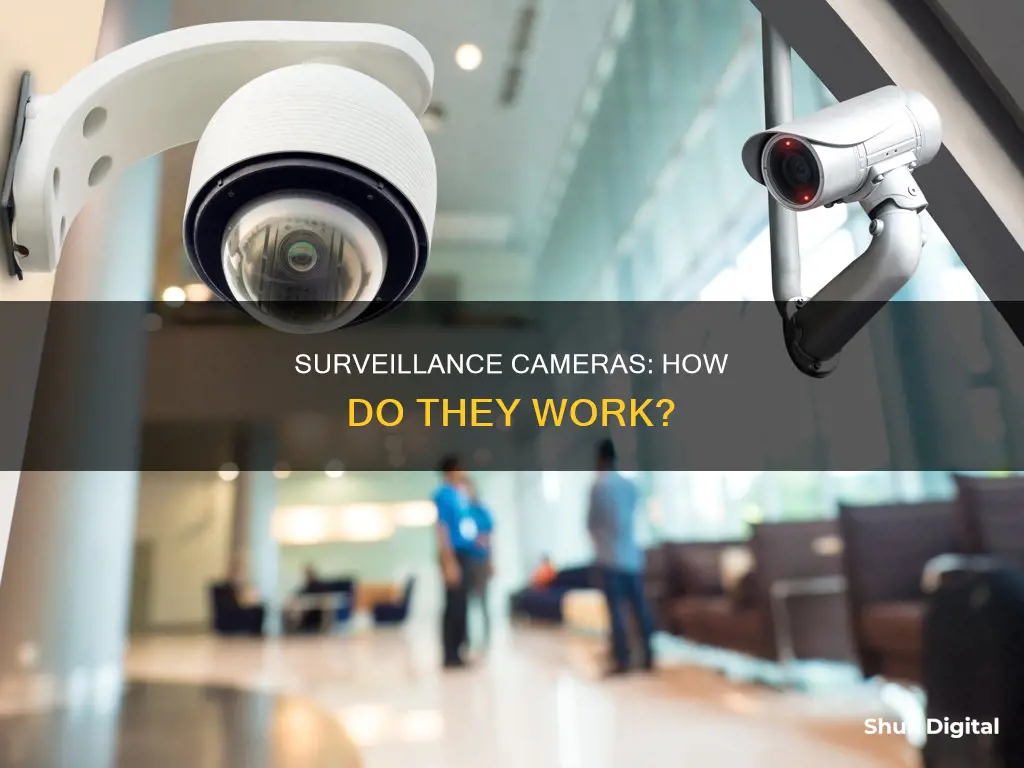
Surveillance cameras are an increasingly common feature of modern life, with around 350 million in use worldwide as of 2016. They are video cameras used to monitor an area, often connected to a recording device or IP network, and may be watched by security staff or law enforcement.
Surveillance cameras are usually placed in public spaces and are used to detect and prevent criminal activity. They may be hidden from view or openly visible, and can be paired with smart devices like alarms. They can be monitored remotely and receive alerts via SMS, mobile apps, or other notification systems.
The footage they capture can be used to investigate crimes and as evidence in legal proceedings. They can also be used to monitor employee productivity and to observe and record special events.
Surveillance cameras are an important part of security systems, alongside access control and alarms, and are a useful tool for law enforcement and security personnel.
| Characteristics | Values |
|---|---|
| Purpose | Identify and deter criminal conduct |
| Placement | Strategically positioned in public areas |
| Visibility | Usually openly visible |
| Function | Monitor consumer traffic and business activities |
| Alert System | Can be paired with smart devices like alarms |
| Recording | Transmit video to a recorder, either digitally or by cable |
| Data Storage | Transmit data over LAN, Wi-Fi, or cellular networks |
| AI Integration | Integrated with AI |
| Use Case | Industrial facilities, highly dense areas, retail stores, office buildings, parking lots |
What You'll Learn
- Surveillance cameras are used to monitor public spaces, while security cameras are used to monitor consumer traffic and business activities
- Surveillance cameras are often hidden from view, while security cameras are visible
- Surveillance cameras are integrated with AI and can be paired with alarms, while security cameras are just cameras that record footage
- Surveillance cameras are used to detect and prevent criminal activity, while security cameras are used to deter crime
- Surveillance cameras are strategically placed in public areas, while security cameras are commonly found in retail stores, office buildings, and parking lots

Surveillance cameras are used to monitor public spaces, while security cameras are used to monitor consumer traffic and business activities
Surveillance cameras are typically used to monitor public spaces, such as streets, parks, intersections, schools, stores, and transportation hubs. They are often placed in areas with high foot traffic or where criminal activity is likely to occur, such as retail shops, parking lots, museums, and concert halls. Surveillance cameras can be mounted in plain sight or hidden from view, and they may be connected to a central monitoring station or a control centre where security personnel can view the footage in real time.
One of the primary purposes of surveillance cameras is to deter crime and improve public safety. The presence of these cameras can discourage potential criminals from engaging in illegal activities, as they know they could be caught on camera. In the event of a crime, surveillance footage can provide valuable evidence for law enforcement, helping to identify and catch criminals. Facial recognition technology, for example, can be used to identify and locate suspects. Surveillance cameras can also help in gathering clues and providing evidence during investigations, which can be crucial in solving crimes and bringing perpetrators to justice.
Surveillance cameras are also used for traffic monitoring and control. Strategically placed at intersections, on-ramps, and areas with heavy congestion, these cameras provide a comprehensive view of traffic flow and conditions. This information is useful for traffic engineers and law enforcement to monitor traffic in real time, detect accidents, and take appropriate action to improve traffic safety and alleviate congestion. Some traffic monitoring cameras are equipped with speed sensors, allowing authorities to enforce speed limits and issue tickets to speeding drivers.
While surveillance cameras offer numerous benefits, there are also concerns and challenges associated with their use. Privacy is a significant concern, as some individuals feel that surveillance cameras invade their privacy and constantly monitor their movements in public spaces. The potential for abuse of surveillance footage, such as voyeurism or blackmail, is another issue that needs to be addressed. Additionally, the effectiveness of surveillance cameras in deterring certain types of crimes, such as those committed by suicidal bombers, has been questioned.
On the other hand, security cameras are commonly used to monitor consumer traffic and business activities. Also known as CCTV (closed-circuit television) cameras, they are often used in residential areas and private businesses. Security cameras typically activate when motion or sound is detected, and they send video recordings to a designated storage device, such as a DVR or SD card. These cameras can be placed anywhere there is a power source nearby, allowing users to monitor the activities of people within and around the premises.
One advantage of security cameras is that they can act as a deterrent to potential criminals. Visible security cameras can make criminals think twice about targeting a property. Additionally, motion-activated security cameras can help gather evidence by capturing the entry of intruders and providing a timestamp of the incident. However, a disadvantage of security cameras is that they often have lower resolution compared to surveillance cameras, resulting in blurry or grainy images.
In summary, while there are some functional overlaps between surveillance and security cameras, they generally serve different purposes. Surveillance cameras are primarily used to monitor public spaces for crime prevention, traffic control, and improving public safety. On the other hand, security cameras are commonly employed by businesses and homeowners to monitor specific premises and deter criminal activities on their properties.
Speeding Tickets by Camera: Impact on Georgia Insurance Rates
You may want to see also

Surveillance cameras are often hidden from view, while security cameras are visible
Surveillance cameras are often hidden from view, while security cameras are placed in visible locations. Both systems aim to record video footage to observe suspicious activities and deter crime. However, the key difference lies in their purpose and placement. Security cameras are typically installed in retail stores, office buildings, and parking lots to monitor customer traffic and business operations openly. On the other hand, surveillance cameras are strategically placed in public spaces, usually informed by AI, to detect and prevent criminal activity more discreetly.
The placement of security cameras in visible locations acts as a deterrent to potential criminals. Their presence can make criminals think twice about committing a crime or encourage them to take alternative routes that benefit the defender. However, their visibility also has a downside. Criminals can easily identify and avoid or disable these cameras. In contrast, surveillance cameras, being hidden from plain sight, can capture footage that people might not exhibit when they know they are being watched. They are also less likely to be tampered with or vandalized.
For example, a retail store might have a visible security camera to deter shoplifting, but a hidden surveillance camera can identify a thief among the staff or customers. Similarly, a construction site might have a visible camera to deter theft, but a hidden camera can capture footage of employees stealing tools or materials. In a nursing home, hidden cameras can ensure residents receive proper care without the staff being aware of constant monitoring.
Surveillance cameras are also useful in places with high foot traffic, such as busy crosswalks, malls, and airports, to deter criminal activity. They can be paired with smart devices like alarms and activated remotely via smartphone, laptop, or tablet. Additionally, they can detect motion and identify objects in motion, such as people, animals, or vehicles.
While security cameras are effective in deterring crime, surveillance cameras provide a more subtle approach to monitoring and evidence gathering. The decision to use visible or hidden cameras depends on the specific needs and nature of the business or location being monitored.
Mastering Manual Focus: Camera Techniques for Sharp Images
You may want to see also

Surveillance cameras are integrated with AI and can be paired with alarms, while security cameras are just cameras that record footage
Surveillance cameras are an integral component of security systems, designed to monitor and record activities for the purpose of gathering information, deterring improper behaviour, and providing evidence. These cameras can be installed in plain sight or hidden locations, depending on the specific requirements.
Recent advancements have led to the integration of AI with surveillance cameras, enhancing their capabilities. AI-powered cameras can utilise person detection, facial recognition, and intelligent alerts to reduce false alarms and focus on relevant security concerns. For instance, the Nest Cam IQ Indoor uses infrared night vision to discreetly record intruders without them being aware, providing a crisp and clear view.
Surveillance cameras can also be paired with alarms, creating a more robust security system. Security cameras with built-in alarms typically rely on motion detection sensors, either software-based or PIR (Passive Infrared) sensors. When motion is detected, the alarms are triggered, often accompanied by notifications, emails, or text messages. Some advanced systems may include audible alarms, such as sirens, to attract attention and induce vigilance from neighbours or the police.
In contrast, security cameras without AI integration are just cameras that record footage. They may be connected to a recording device or IP network and monitored by security staff or law enforcement. While they serve the basic purpose of surveillance, they lack the advanced features and analytics that AI-integrated cameras offer.
By incorporating AI and alarm systems, surveillance cameras become a more proactive tool in enhancing security, deterring crimes, and providing valuable evidence when needed. The combination of AI and alarms elevates the effectiveness of surveillance systems, making them a preferred choice over standard security cameras.
Focusing Your Camera in Unity: A Step-by-Step Guide
You may want to see also

Surveillance cameras are used to detect and prevent criminal activity, while security cameras are used to deter crime
Surveillance cameras are strategically placed in public spaces and are often integrated with AI technology to detect and prevent criminal activity. They are typically monitored by law enforcement or security staff, who can respond to incidents in real time. Surveillance cameras are often hidden from public view, and their footage can be accessed remotely and analysed forensically. They are commonly used in areas with high levels of illegal activity, such as red-light districts and train stations, and can be paired with alarms and other security measures to enhance their effectiveness.
Surveillance cameras are also used to monitor and control situations, such as traffic and crowd management. They can be equipped with advanced features like high-resolution imaging, night vision, and facial recognition technology. These cameras are designed to capture and record video footage, which can be used as evidence by law enforcement. The use of surveillance cameras has been criticised by civil liberties activists due to concerns about privacy violations.
On the other hand, security cameras, also known as CCTV or "closed-circuit television" cameras, are commonly found in retail stores, office buildings, and other private businesses. They are typically placed in visible locations to deter criminal activity and monitor consumer traffic and business activities. Security cameras usually activate when motion or sound is detected and send recordings to a designated storage device. While they can help identify suspects and gather evidence, they have limited ability to prevent crimes in progress.
Both surveillance and security cameras have their advantages and disadvantages. Surveillance cameras offer advanced features and continuous recording, making them effective tools for crime detection and prevention. However, they can be complex to manage and vulnerable to hacking. Security cameras, on the other hand, are easier to use and more affordable, but they may not provide the same level of detail and functionality as surveillance cameras.
Ultimately, the choice between surveillance and security cameras depends on the specific needs and requirements of the user. Both types of cameras play a crucial role in maintaining safety and security, but they serve different purposes and are suited to different environments.
Wireless Security Cameras: How Long Do They Last?
You may want to see also

Surveillance cameras are strategically placed in public areas, while security cameras are commonly found in retail stores, office buildings, and parking lots
Surveillance cameras are video cameras used to monitor an area for the purpose of observing and gathering information. They are often connected to a recording device or IP network and may be watched by security staff or law enforcement. Surveillance cameras are typically placed in public areas to identify and deter criminal activity.
Security cameras, also known as CCTV or "closed-circuit television" cameras, are commonly found in private spaces such as retail stores, office buildings, and parking lots. They are used to monitor public activity and record footage, which can be used as evidence in criminal investigations. Security cameras can be placed anywhere there is a power source nearby and can be set to activate when motion or sound is detected.
Surveillance cameras, on the other hand, are often placed in public spaces like streets, parks, and crosswalks to monitor population movements and prevent crime. They are usually openly visible and can provide a 360-degree seamless surveillance solution. Surveillance cameras are integrated with AI and can be paired with smart devices, such as alarms, to take immediate action when something happens.
While security cameras transmit video data through physical data cables to local storage devices, surveillance cameras use digital signals to store transmitted data. Surveillance cameras can send real-time recordings to a central location within a local area network (LAN) or through Wi-Fi or cellular networks. They provide continuous recording, whereas security cameras typically only activate when triggered by motion or sound.
The placement of surveillance and security cameras depends on their purpose and the specific security needs of a facility. While both types of cameras have their advantages and disadvantages, they play a crucial role in enhancing security and protecting public safety.
Bridge and Camera Raw: The Perfect Pairing
You may want to see also
Frequently asked questions
A surveillance camera is a type of camera used for monitoring public or private spaces, often for security purposes. They are typically connected to a recording device or network and may be monitored by security staff or law enforcement.
Security cameras are commonly used to monitor customer traffic and business operations in retail stores, office buildings, and parking lots. Surveillance cameras, on the other hand, are strategically placed in public spaces to detect and deter criminal activity. They are often integrated with AI and can be paired with alarms and other smart devices.
Surveillance cameras can help improve public safety, reduce crime rates, and provide convenient remote monitoring capabilities. They can also be used to investigate crimes and monitor employee productivity.
Yes, one major concern is privacy. It is important to balance security needs with respecting individuals' right to privacy. Additionally, surveillance systems can be costly to maintain and upgrade, and they may experience technical glitches.







